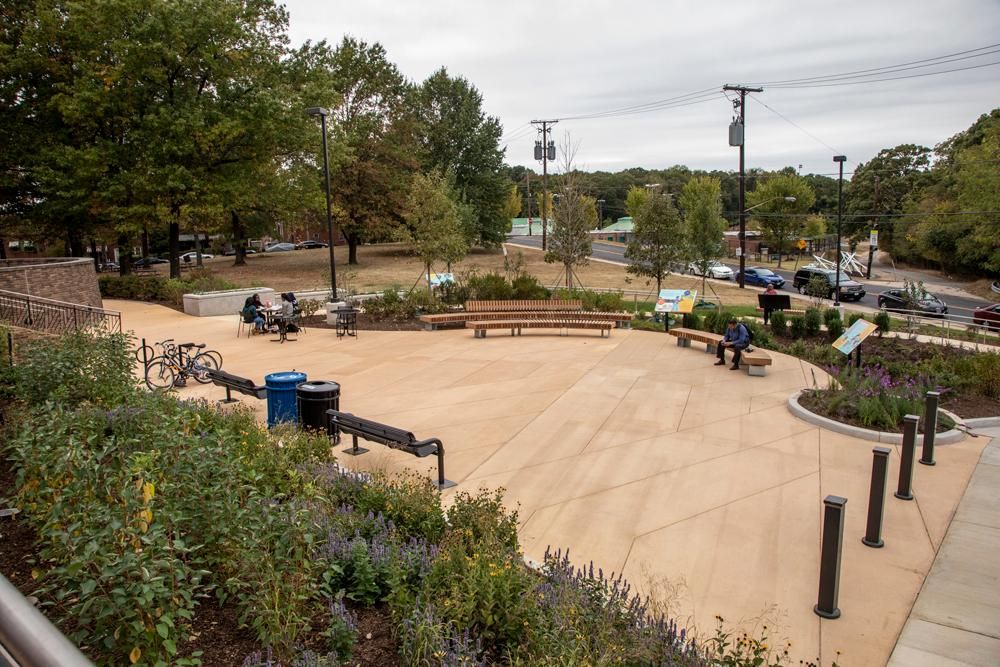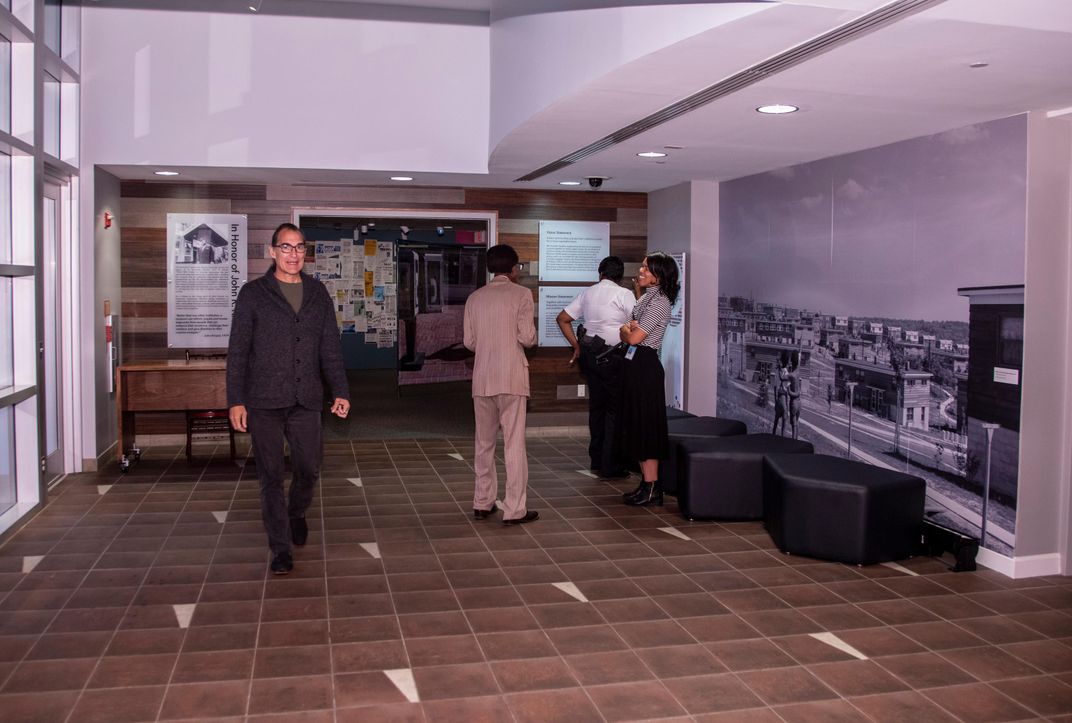At the Anacostia Community Museum, a Sleek New Look Comes with a New Director
With a hyper-local focus on neighborhood concerns, this Smithsonian museum is a mighty influencer
/https://tf-cmsv2-smithsonianmag-media.s3.amazonaws.com/filer/e5/41/e541ee4d-e3dc-45df-b3ef-4eaa6a235dd4/2019-08008.jpg)
“A Right to the City,” the current exhibition on view at the Smithsonian’s Anacostia Community Museum looks at a handful of D.C. neighborhoods where residents banded together to fight or recover from the nation’s first urban renewal projects, expressways that would rip through communities, or schools that would rise from segregation to serve all more fairly.
But another story could be added about the museum itself.
The Anacostia Community Museum is just reopening its doors after a seven-month, $4.5 million improvement project that amplifies the 52-year-old museum's welcoming outreach to the nearby neighborhoods. In addition to its most obvious changes, with a redesigned landscape developed with Smithsonian Gardens to be more reflective of the Anacostia watershed, the interior spaces have been reconfigured with a mind to the community and all the lighting, heating and air conditioning has been updated.
Amid all that change, the museum also has a new director as well.
Melanie A. Adams brings more than 25 years of experience in community engagement in museums and higher education, including the Missouri Historical Society and most recently the Minnesota Historical Society. She replaces Lori Yarrish, who died in August 2018 at 58 after a brief illness.
Raised in New Jersey with a degree from the University of Virginia, Adams says she’s been long aware of the Smithsonian’s smallest D.C. museum. “The Anacostia Community Museum has been a model around the country for community-based museums,” she says. “Even before this job was posted, during my time in Missouri, I was always looking to this museum for the great work that they were doing.”
/https://tf-cmsv2-smithsonianmag-media.s3.amazonaws.com/filer/83/0f/830f2654-cc13-401f-8d1c-62e93d3550d3/acm_director_adams_welcome_at_open_house_ro.jpg)
More than four miles from the National Mall where many of the other Smithsonian museums are located, the Anacostia Community Museum drew 33,700 visitors last year, compared to the 6.2 million at the National Air and Space Museum and 4.8 million at the National Museum of Natural History.
“I’m never going to have the numbers that they have on the Mall,” Adams says. “But when you look at the stories we’re telling here, we’re the Smithsonian’s way of diving deeper into the community.”
Attendance will be further down this year because of the seven-month closure, which began in March, with only a three-week notice because of the 35-day partial government shutdown (that shuttered the museum for an additional 35 days in December and January).
For Adams, the closure “gave me a good opportunity to get to know my staff, my board and other Smithsonian colleagues. But towards the end, I was dying for it to open!”

What had begun as a site security project quickly moved to improvements to be more welcoming, says Sharon Reinckens, the museum's deputy director who helped oversee the changes.
With big hedges cutting the building off from the street, no stairway or other pedestrian pathway to the front door other than a bus turnaround, a new direction was needed, she says.
“It was pretty much concrete and a few trees,” Reinckens says. “The idea was to enhance the exterior of the site to make it more welcoming and engaging for our audiences across the nation. We kind of re-sculptured the site, and in the process, we created a community garden.”
What began as a drainage site turned into a permanent teaching installation about the Anacostia Watershed, river restoration projects and the site’s first inhabitants, the Nachotchtank.
Inside, space was reconfigured to allow public access to a patio, and the creation of an internet lounge where visitors can sit, charge phones, or attend a series of nighttime activities planned weekly starting in January. Or maybe it could simply be a place to hang out, Reinckens says. “You go to a coffee shop; you go to the museum.”

While “A Right to the City” has been open since April 2018, it’s now joined by an exhibition created by nine home-schooled teens from Arlington County, Virginia, about gentrification titled “Gen Z Speaks: A Right to the City” that reflects their research and points of view.
The main exhibition, which continued to be represented during the construction with satellite versions of the show at four neighborhood public libraries, is further enhanced in the reopening by a series of maps that add context to the neighborhoods studied—Adams Morgan, Anacostia, Brookland, Chinatown, Shaw and Southwest.
A rare film of Martin Luther King speaking at a parade and rally in Shaw in 1968 serves as a kind of unifying message about community involvement overall: “Prepare to participate!”
And while there are a number of local leaders featured in the individual sections, there are also nearly 200 oral histories that can be heard at a phone booth, as well as an opportunity to record and share their own neighborhood stories.
But as specific as these stories can be, the value of the Anacostia Community Museum is that they can be universal.
“We really take a hyper-local look at issues. We look at the D.C. region and look at specific issues,” Adams says. “But they also resonate around the world in urban areas. We like to say you could take ‘A Right to the City’ and pick it up and put it in any urban area in the country, change the name of the neighborhoods, and you would have very similar stories, whether that’s issues of housing, freeways or education.”
Work has begun on the next big exhibition there, with the working title “D.C. Eats,” which Adams describes as “a kind of food history of the region but will also look at very current issues around food in terms of food insecurity, deserts, social justice issues related to food.”
But November will begin a strategic planning process for plans further down the road.
“One thing we want is to do an audience survey to figure out who is our audience and what do they want,” she says. “I think this is a great time to do this with the reopening of the building. We just celebrated our 50th anniversary back in 2017. This allows us to see who we want to be for the next 50 years.”
“A Right to the City” continues through April 20, 2020 at the Anacostia Community Museum, 1901 Fort Pl., SE, Washington, D.C. The hotline number to hear or contribute D.C. neighborhood stories is 202-335-7288.
/https://tf-cmsv2-smithsonianmag-media.s3.amazonaws.com/accounts/headshot/RogerCatlin_thumbnail.png)
/https://tf-cmsv2-smithsonianmag-media.s3.amazonaws.com/accounts/headshot/RogerCatlin_thumbnail.png)